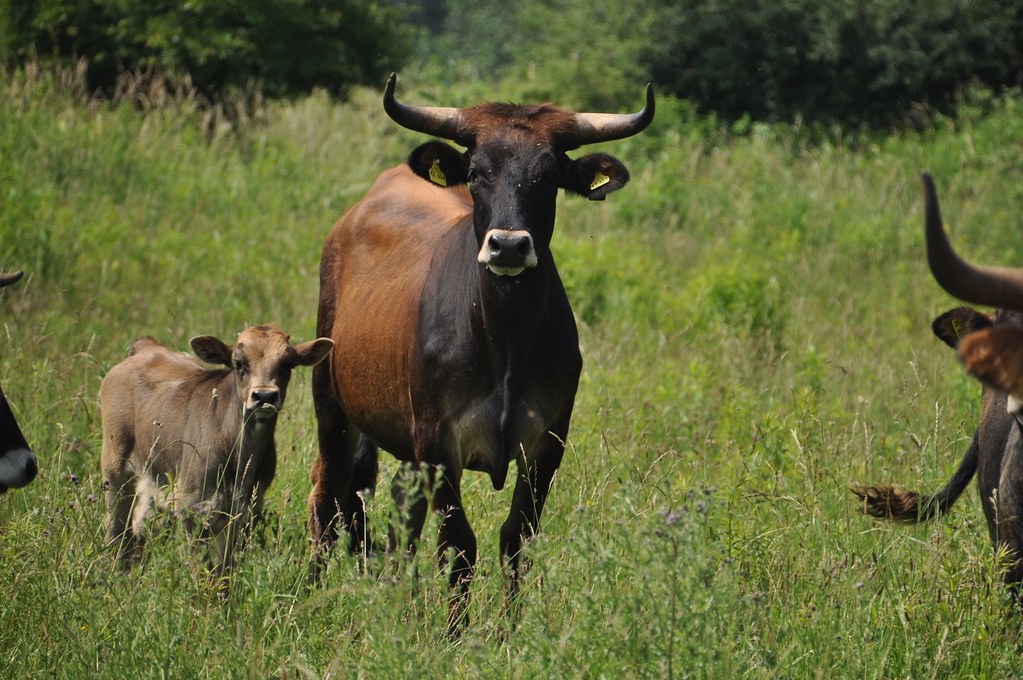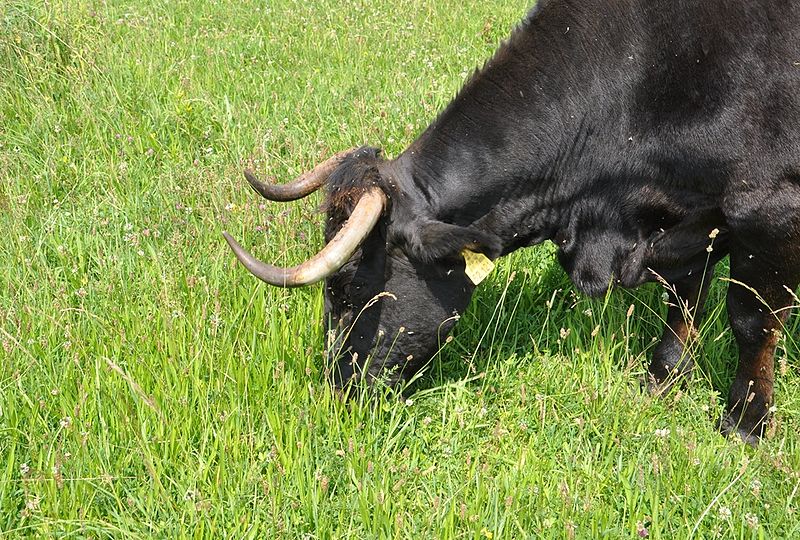Sayaguesa
is a breed from the Spanish province of Zamora in the northwest of Spain, and
it preserves a number of features that make it very useful for breeding back. There
are about 640 individuals of this endangered breed. It’s a large breed with
cows reaching 145-150 and bulls reaching 150-165 cm at the shoulders (these
numbers are based on several measurements I found in the web, and also personal
information). One of the Sayaguesa cows I saw at the Lippeaue, Germany, was a
really large one. Her head alone might have been 50 cm long.
Besides the
size, the long-legged body of Sayaguesa, especially in the cows, produces
useful crosses. Although the body is not as athletic as in the Spanish Fighting
bull, many Sayaguesa still have a comparably muscular and slender body and also
a decent hump at the shoulders (this feature is very prominent in some
individuals).
 |
| Sayaguesa cow of the Tauros Program with a very large hump |
 |
| Typical Sayaguesa cow in the Lippeaue |
Sayaguesa
is one of the few breeds that retained a really long skull, especially in cows.
In the Lippeaue, I saw a skull of a Sayaguesa cow, and although there’s still
some decaying flesh on it, you can see the basic shape of that skull on the
photo. It matches up quite well with some aurochs skulls, except that the frontal bones are not as elongated (probably because it is not as large-horned).
 |
| Sayaguesa cow skull in the Lippeaue |
Sayaguesa
basically have a correct Aurochs colour, but the sexual dimorphism sadly is
very reduced because the Spanish breeders select against it. Consequently, many
Sayaguesa cows have a bull coat colour. And selection for a totally black
colour also reduced the wild markings in some bulls, such as the mealy mouth
and eel stripe. But luckily there are still examples of “correctly” coloured Sayaguesa,
even very reddish cows that display the typical sexual dimorphism of wild
cattle.
 |
| Aurochs-coloured bull of Tauros Project |
 |
| Red Sayaguesa cows in the Lippeaue (those with red ear marks) |
The colour
of Sayaguesa has proven to be very useful in crossbreeding. In bulls, Sayaguesa
results in a beautiful deep black colour with an eel stripe, even if the father
was lightly coloured. Female offspring, on the other hand, usually is coloured
reddish brown when crossed with lightly coloured cattle, as the crosses with
Alistana-Sanabresa (Tauros Programme) and half-Chianina (Taurus cattle) have
shown. Unfortunately, some Sayaguesa have white spots on the belly because of
the crossing with more-derived breeds in order to improve it as economic
cattle.
 |
| 75% Sayaguesa, 25% Alistana-Sanabresa (Tauros Project) |
 |
| 75% Sayaguesa, 12,5% Heck, 12,5% Chianina (Taurus cattle) |
The horns
of Sayaguesa can either be useful or problematic for breeding-back. They are
usually medium-sized, and oriented forwards. Many cows have horn tips curving
outwards, like in many Iberian breeds. Some individuals, on the other hand,
have horns curving inwards as in the Aurochs, f.e. one of the cows I
photographed at the Lippeaue. Others are intermediate.
 |
| Sayaguesa cow with well-shaped horns (Lippeaue) |
And of
course Sayaguesa is hardy, used to poor forage and does very well in the
winters of Germany and the Netherlands. So do all other hardy Iberian breeds,
there is no reason to assume that southern-European primitive breeds would not
do well in Central and Northern Europe.
All in all,
Sayaguesa is a very useful breed for breeding-back. It’s large, has long legs,
a well-pronounced S-curved back, a long and straight skull and a colour that
isn’t perfect but can result in correct offspring when crossed properly. The
quality of that breed has been proven by many crosses of Taurus and also
Tauros. That’s why this breed is used in Taurus cattle and Tauros Programme to
a large extent, it certainly is a very aurochs-like breed. Sayaguesa also is
used in grazing projects in the Netherlands independently from Tauros Project,
in areas such as Planken Wambuis and in the Veluwe (alongside Tudanca).
The sad
aspect is that many breeders in Spain select against wild type features, what
means that breeding-back should collect the remaining good individuals of that
breed. In my opinion, starting herds with some very good Sayaguesa and
supplementing them with individuals from other breeds could result in a very
aurochs-like improved Sayaguesa lineages that are fit for being released as
Aurochs proxies. The Tauros Programme wants to set up a herd of Sayaguesa cows
in Spain that will be covered by a good Maremmana primitivo bull. After adding
further breeds and some selection, the results might resemble the aurochs very
well already.
Here is a video of Sayaguesa in the Netherlands, part of the Tauros Project:

Those breed has a long snout. The Alentejana breed also has a very long snout.
ReplyDeleteThere is in Spain another cattle also very similar to the old auroch -uro or bos primigenius- called "Alistano Sanabresa". The two breeds are in inminent risk of dissappear
ReplyDelete